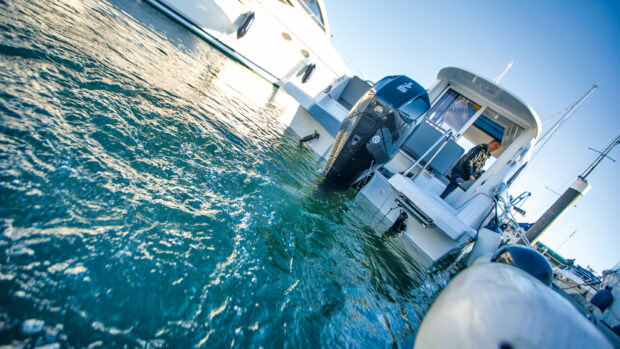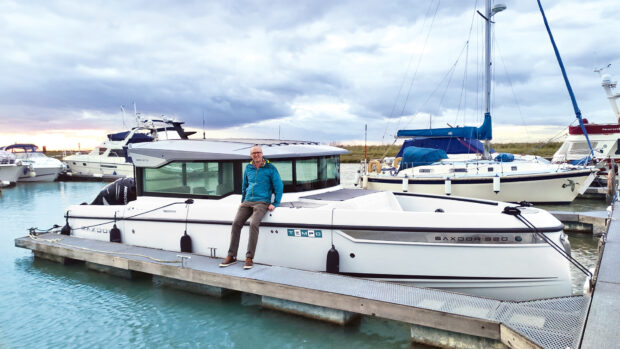There are a lot of options so it’s important to have a clear idea of your priorities when looking for a first boat. Where will you use and keep it? Who will you use it with? Will you use it all year round or just for some summer fun?
Get a clear idea of how you intend to use your boat and narrow down your choice of boat from there. With a starter boat it makes sense to start small to keep the boat and its related costs manageable.
There is nothing stopping you from choosing a bigger boat as a first-timer but a smaller boat will be easier to handle and maintain.
RIBs (Rigid Inflatable Boats) make excellent starter boats as they’re relatively affordable, safe and – most importantly – surrounded by an inflatable rubber bumper in the event of any unforeseen berthing mishaps!
Article continues below…

How to buy a used boat: Everything you need to know to buy with confidence

How to buy a new boat: Everything you need to know about brokers, dealers and yards
How to choose the right hull shape
The three main hull types are displacement, semi-displacement (sometimes referred to as semi-planing) and planing.
A boat with a displacement hull pushes through the water rather than over it, which in most cases restricts the boat’s speed to a formula based on its waterline length (1.34 x√LWL).
This equates to between 6-10 knots for boats in the 20-50ft category. Displacement boats tend to be heavier than planing craft and well suited to either inland waters, where speed limits apply, or long-distance cruising where fuel efficiency and seaworthiness are paramount. A semi-displacement hull is capable of creating some dynamic lift at speed but most of the vessel’s weight is still supported by buoyancy.
 Watch the video
Watch the videoThis hull shape, favoured by the likes of Fleming Yachts, is a best-of-both-worlds solution that can travel long distances comfortably and efficiently at displacement speeds but can also up the pace to 20 knots or more for shorter distances, albeit while using considerably more fuel.
These days most entry-level motorboats have planing hulls. Designed for cruising efficiently at higher speeds, they create dynamic lift, allowing them to rise up onto the surface reducing drag and allowing them to skim across the waves rather than push through them.
The downside of a planing hull is that it can slam uncomfortably in rough seas and isn’t as well suited to displacement cruising as a smoother round-bilge hull shape.

How to choose boat engines
For leisure motorboats the most popular engine types are outboard, inboard sterndrive, inboard shaftdrive and inboard pod drive. Planing boats below 40ft are most likely to have either outboards or inboard sterndrives.
An outboard is generally petrol powered (with a few notable diesel outboard and electric outboard exceptions) and mounted on the transom at the back of the boat.
This makes an outboard easy to access for maintenance, frees up space inside the boat and the propeller lifts clear of the water when not in use to help prevent fouling and corrosion.
An inboard engine, which can be petrol or diesel, sits inside the hull and propels it either via a sterndrive leg mounted on the transom or via a shaft that passes through the bottom of the hull with a propeller on the end of it and a rudder behind it for steering.

A single sterndrive makes for superb handling
Sterndrives (and outboards) steer by pivoting from side to side to change the direction of thrust. Pods are generally used on craft from 40-75ft and in multiples of two or more.
They tend to be more efficient than shaftdrives and take up less space but the major benefit is joystick manoeuvring. This allows the helmsperson to push the joystick in the direction they want to go and let the computer steer the pods independently to make it happen.
Recently, joysticks have become available for twin sterndrive, shaftdrive and even outboard boats so they are no longer the preserve of pod drive craft. Bow and stern thrusters – small propellers facing sideways at either end of the boat – are another means of helping with docking manoeuvres.
There are pros and cons for all of these engine and drive partnerships but it’s best to be guided by what boat is right for you and not just the type of engine and drive system it has.
First published in the May 2021 issue of Motor Boat & Yachting. Our How to start boating series is brought to you in association with Pantaenius.










